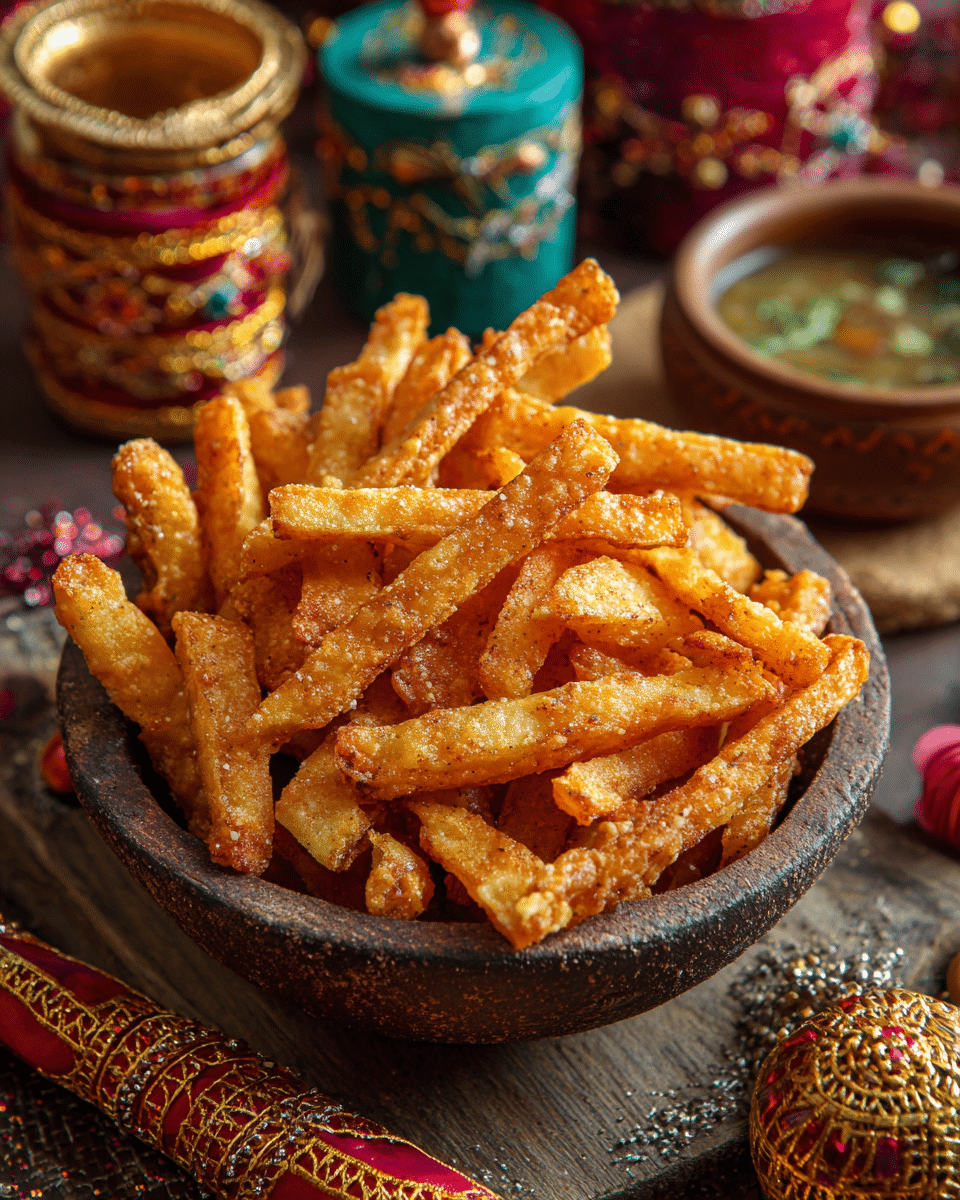Namak Para is a classic North Indian savory snack made with all-purpose flour and a blend of spices, deep-fried to a golden crisp. Traditionally prepared during festivals like Diwali and Rakhi, it’s crunchy, addictive, and perfect for festive gatherings or teatime munching. Its simplicity and long shelf life make it an ideal make-ahead snack to enjoy with friends and family during celebrations.
FULL RECIPE
Ingredients
- 1½ cups all-purpose flour (maida)
- 2 tablespoons semolina (sooji/rava)
- 1 teaspoon carom seeds (ajwain)
- 1/2 teaspoon cumin seeds
- 1/2 teaspoon black pepper, crushed
- Salt to taste
- 2 tablespoons oil or ghee (for dough)
- Water (as needed for kneading)
- Oil for deep frying
Directions
- Mix dry ingredients: In a large bowl, combine flour, semolina, carom seeds, cumin seeds, crushed black pepper, and salt.
- Add fat: Pour in the 2 tablespoons of oil or ghee. Mix well until the flour resembles breadcrumbs. This step helps create a flaky texture.
- Knead dough: Slowly add water, a little at a time, and knead into a stiff yet smooth dough. Cover and let it rest for 15–20 minutes.
- Roll and cut: Divide the dough into two portions. Roll each portion into a thin sheet (around 1/8 inch thick). Use a knife or pastry cutter to cut into diamond or square shapes.
- Heat oil: Heat oil in a deep pan on medium heat. Drop a few pieces of dough into the oil.
- Fry until golden: Fry the Namak Para in batches, stirring occasionally, until they turn golden and crisp. Make sure to maintain medium-low heat to ensure even cooking.
- Drain and cool: Remove from oil and drain on paper towels. Let them cool completely before storing in an airtight container.
Nutrition Facts
- Calories: 180 kcal
- Carbohydrates: 22g
- Protein: 3g
- Fat: 9g
- Saturated Fat: 1.5g
- Fiber: 1g
- Sugar: 0g
- Sodium: 180mg
- Cholesterol: 0mg
Cultural Significance of Namak Para
Namak Para holds a special place in Indian households, particularly during festivals and family gatherings. It is a staple snack during Raksha Bandhan, Diwali, and Holi, often made in large batches as part of festive preparations. Its crisp texture and savory taste make it a favorite among all age groups, and its preparation is often a communal activity shared by family members. Making Namak Para at home is not only a culinary tradition but also a way of preserving cultural rituals, passing them down through generations while bringing families together.
Texture and Taste Profile
One of the defining features of Namak Para is its ultra-crispy texture, which comes from kneading a stiff dough and frying it over medium-low heat. The addition of carom seeds and crushed black pepper imparts a warm, earthy, and subtly spicy flavor, enhancing the dough’s bland base. It is mildly salty, not overwhelming, allowing the taste of the flour and spices to shine. The overall experience is crunchy, flaky, and satisfyingly savory—perfect for snacking at any time of the day, especially with a cup of hot tea.
Healthier Ingredient Alternatives
Although traditionally made with all-purpose flour and deep-fried, Namak Para can be adapted for a healthier diet. Whole wheat flour can replace all-purpose flour to increase fiber content. Semolina, already present in the recipe, contributes to crunch and can be used in a higher proportion for more texture. To reduce oil content, Namak Para can be baked or air-fried, although the texture may vary slightly. Using olive oil instead of vegetable oil or ghee provides healthier fats, and reducing the amount of salt can lower sodium levels without compromising flavor.
Easy Variations to Try
Namak Para is highly customizable. You can add dried herbs like kasuri methi (dried fenugreek leaves) for a fragrant twist or a pinch of turmeric for color and subtle flavor. For a spicier kick, red chili powder or crushed green chilies can be incorporated into the dough. Some versions include sesame seeds or nigella seeds to boost flavor complexity. For a unique twist, a sweet version called shakkarpara uses sugar syrup and is popular in Maharashtra and Gujarat. These variations allow home cooks to experiment while maintaining the essence of the snack.
Serving Suggestions for Gatherings
This snack is best served as part of a festive platter alongside other savories like mathri, chakli, or samosas. It’s also a great accompaniment to hot beverages like masala chai or filter coffee. During Rakhi, Namak Para can be elegantly presented in decorated trays or gift boxes alongside sweets like laddoos and barfi. For a modern twist, you can serve it with flavored yogurt dips, tamarind chutney, or spicy hummus. Its versatile flavor makes it suitable for both traditional and fusion-themed gatherings.
Storage and Shelf Life
One of the advantages of Namak Para is its excellent shelf stability. Once cooled completely, it should be stored in an airtight container to retain its crispness. Properly stored, it can last up to 3 weeks without losing texture or flavor, making it ideal for advance preparation. It’s best to keep it in a cool, dry place away from humidity, as moisture can make it soggy. Labeling the container with the date of preparation can help track freshness, especially when making large quantities for festive events.
Pairings with Beverages
Namak Para pairs exceptionally well with a variety of Indian and international beverages. The classic pairing is with hot masala chai, which balances the savory flavors with aromatic warmth. It also goes well with coffee, spiced buttermilk, or herbal teas like tulsi or ginger tea. For more adventurous combinations, Namak Para can be served with sparkling lemonade or mango panna. These beverages refresh the palate and contrast nicely with the crunchy, salty snack, making for a well-rounded teatime or party experience.
Kid-Friendly Snack Option
Because Namak Para is mild in flavor and easy to chew, it’s a hit among children. You can shape the dough into fun forms like stars, sticks, or mini hearts to make it visually appealing. Reducing the spice level and using whole wheat flour makes it a healthier option for lunchboxes or after-school snacks. You can even let kids participate in cutting the dough shapes, turning it into a fun, family-friendly cooking activity. Serve it with a side of fruit or yogurt for a more balanced mini-meal.
Festive Gifting and Packaging Ideas
During Rakhi and Diwali, Namak Para makes a great edible gift. It can be packaged in mason jars, eco-friendly pouches, or decorative tins with ribbons and labels for a personal touch. Combine it with other homemade treats to create a savory-sweet snack box for friends and family. Adding a handwritten note or a small Rakhi thread with the packaging enhances the sentiment. Since it stays fresh for weeks, it’s also ideal for shipping to loved ones who live far away, ensuring a taste of home arrives safely.
Advertisement
Tips for Perfect Results
Achieving perfectly crispy Namak Para requires a few key techniques. First, make sure the dough is stiff but smooth; soft dough will absorb more oil and turn soggy. Adding fat (oil or ghee) to the dry ingredients before kneading ensures flakiness. Resting the dough allows gluten to relax, making rolling easier. Frying over medium-low heat ensures that the snack cooks evenly from the inside and doesn’t burn. Avoid overcrowding the frying pan, as that can lower the oil temperature and result in uneven cooking.
Conclusion
Crispy Namak Para is more than just a snack—it’s a celebration of tradition, taste, and togetherness. Perfect for Rakhi gatherings or any festive moment, it combines simplicity with rich cultural value. From its satisfying crunch to the comforting spices, every bite evokes a sense of nostalgia and warmth. Its adaptability, long shelf life, and ease of preparation make it a cherished addition to Indian kitchens.






